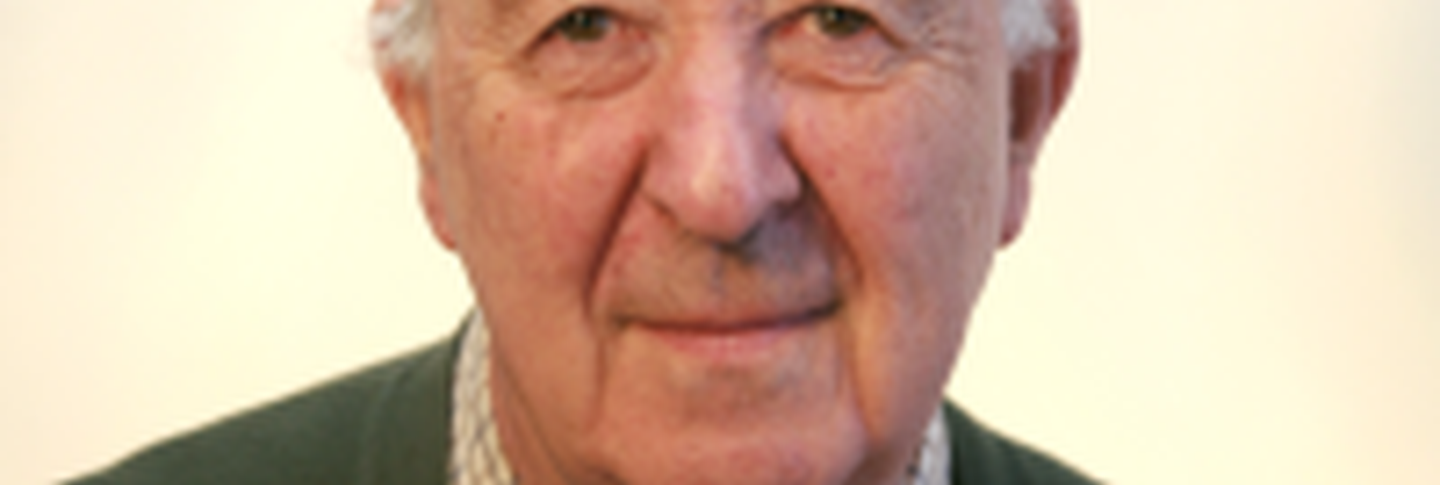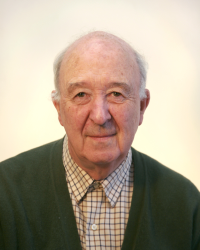Peter Brown, Rollins Professor Emeritus of History at Princeton University, visited Dumbarton Oaks in November with his wife Betsy, who, while she was with us, was looking for patristic origins of Puritan spirituality. Peter worked in the library, and engaged in discussions with fellows and staff. In our discussion we asked him about his current work, the writing up of two lecture series he gave in the year after his retirement as the Philip and Beulah Rollins Professor of History at Princeton. Both develop his work on wealth, published as Through the Eye of a Needle: Wealth, the Fall of Rome, and the Making of Christianity in the West, 350–550 AD (Princeton, 2012). The Page-Barbour and James W. Richard Lectures at UVA were entitled “‘Treasure in Heaven’: Wealth, Labor and the ‘Poor Among the Saints.’ Christian Giving from Paul to Pachomios,” and the lectures for the Institut für die Wissenschaften vom Menschen in Vienna were entitled “For the Ransom of the Soul: Wealth, Death, and Afterlife from Late Antiquity to the Early Middle Ages.” In addition to discussions about his current projects, we also wanted to hear how he first came to Dumbarton Oaks and what his reactions were on returning this fall, as well as his views on the subject of Byzantine Studies and how it has been reconceived since Peter first came to Dumbarton Oaks, nearly forty years ago.
Peter Brown: In one way, my impression of Dumbarton Oaks has never changed. It has always been one of continuous, unbroken gratitude, as solid as the yearly return of gold to the trees in the garden.
I first made contact with Dumbarton Oaks in 1976, through Professor Liz Kennan, while I gave a seminar in the newly founded Center for Early Christian Humanism—as it was then called—at the Catholic University of America. At this seminar, I gave the first version of my book, The Cult of the Saints. There was no part of this book that was not enriched by reading in your library—and enriched beyond my dreams when it came to matters pertaining to the Byzantine and Eastern Christian world. It was my first glimpse of the very top of the world as far as scholarship in my own field was concerned. And it has remained this for me, as my subsequent visits have proved to me on every occasion.
The library has always been like a dream. Previously, it was a somewhat surreal dream made up of delightfully incongruous mixtures—of Louis Quinze boudoirs filled with copies of Pauly-Wissowa. One felt like a bee surrounded by honey stored in innumerable little cells. Now, the dream is quite futuristic. I have never seen such long shelves. They give a message that is very much part of Dumbarton Oaks. Here is God’s plenty. At the touch of one green button (and after a wait of five beeps!) an entire tract of history, an entire discipline, an entire region swings open. It is all there.
But what really lingers in my mind from that time was the museum. It rendered visible to me all that was most fascinating and enchanting about late antiquity as I then thought of it. Objects which, in photographs and in learned monographs, seemed somehow frozen, took on new life for me as I viewed them, for the first time, face to face in the quiet of the museum. The Hestia Polyolbos, the Seasons Sarcophagus, the choice pieces of late classical ivory work and silverware: these radiated an almost remissive beauty which dissolved the somewhat tired categories of sacred and profane, pagan and Christian, classical, post-classical, and Byzantine. This was the living world of late antiquity come true.
I now realize that what I thrilled to instinctively at the time, when looking at the works of art in your museum, was a visual manifestation of the aspirations of an entire generation of Byzantine scholars. To trace the continuity of Byzantium with the classical past, and to study the transmutation of this classical heritage into a distinctive religious civilization that, for centuries, had joined Europe to the Middle East and the Mediterranean to the wide spaces of Eurasia as far as Novgorod, the Caucasus, and the Silk Road, was the inspiration and the joy of the great scholars of that age. In Byzantium, a legacy from the ancient past had been preserved, transmuted, and elaborated for over a millennium, leaving its imprint on peoples and on regions of which the ancients themselves had barely dreamed. Dumbarton Oaks was the place where unparalleled resources of scholarship and a unique atmosphere of patient learning was brought to bear on the study of a precious legacy and its mutations.
Among the great Byzantine scholars whom I had absorbed by the time of my first visit to Dumbarton Oaks, no one had understood this better than Norman Baynes:
“The defense of a way of life. Yes, really that essay must be written. It would even have its relevance for us today.”Norman Baynes, The Hellenistic Civilization and East Rome (Oxford University Press, 1946) in Byzantine Studies and Other Essays (London: University of London Athlone Press, 1960), 1-23, at 23.
In postwar Europe and America, the theme of the survival of a way of life rooted in the classical world, as it took on its novel, Byzantine form—often in the face of bitter defeats and recurrent crises—had a sharp taste to it that made the quiet beauty of the objects in the museum seem all the more poignant to us.
How has this changed? In many ways, not at all. The books are still there. The skills are still needed. The artifacts continue to demand care and interpretation. If anything, it is we who have changed. We, in Europe and America, find ourselves in a wider world than we had dreamed of, even forty years ago. And Byzantium has changed with us. We have come to see Byzantium less as a treasure house and more as a crossroads. For a student of late antiquity, the mutation of the classical legacy in Byzantium has come to be seen as one of a wider constellation of mutations of the ancient heritage. These mutations stretch from the medieval Latin West, through the cultures of the eastern provinces, to Iran and to the very roots of the civilization of what would become (always more gradually than we think) the world of Arabophone Islam.
This new outreach is possible because entire linguistic zones and cultures are no longer seen as alien to a Byzantine core. Rather, the intervisibility of the regions has come to be stressed. This is shown in the ever-widening horizons of the study of late antiquity (many aspects of which have come to demand, as never before, knowledge of Oriental Christian languages and, eventually, of Arabic) and (at the end of the story) in the intensive, revisionist study of the transformation of the legacy of Byzantium in Ottoman Turkey, quite as much as in the Orthodox countries of the Balkans and Eastern Europe. Instead of an embattled world, we are faced with a constellation of regions and cultures that we now see as fellow-participants with Byzantium in the vast experiment in civilized living that makes the study of the pre-modern Mediterranean and the Middle East both exciting and necessary for our understanding of these regions in our own times. If for different reasons, the study of Byzantium has become no less relevant than it was for Norman Baynes at the beginning of the postwar period.
What was perhaps most rewarding of all, for me in this last week, was to make contact with so many young scholars from different lands. For many of them an “open” Byzantium can now be taken as a matter of course. This is shown by their enthusiasm not only for Greek but also for oriental languages, such as Syriac, Armenian, Coptic, and Arabic. For others, our understanding of the long and exquisite debate of Byzantium with its own classical past is heightened by greater awareness of the parallel cultural modes of Byzantium’s neighbors both to the west and to the east. Furthermore, the new interest in material culture widens our inner image of Byzantium itself. It reveals a mighty imperial system coming to grips with the tenacious, “vernacular” traditions of its varied regions.
What struck me most was the basic coherence of the historical culture of these young scholars. We now live in an academic oikoumene of far greater diversity, but also of far greater intervisibility, than we had done in the 1970s. The results of the academic integration of the varied countries of Europe are now showing to best effect in our fellows. Whether from America, Europe, or elsewhere, we have the pick of a remarkable generation produced by a very different system from that to which we were accustomed in the 1970s.
But there is a risk in this new academic culture. The system which now prevails, especially in Europe, puts a high premium on collaborative effort. Even when young scholars are not attached to specific teams in pursuit of specific projects, they are subjected to a discipline of constant interchange through the expansion—one might say the explosion—of conferences and workshops. And it is here, I think, that Dumbarton Oaks can do most to contribute to the young scholars who have emerged from this new system. It gives them something that they do not always have. It gives them leisure and prolonged access to an unparalleled collection of material, so as to develop a voice of their own. Lonely hours in those long stacks, and the ease of interchange in an institution long dedicated to the unhurried pursuit of truth, is what they need most to develop that voice. We give them this unstintingly at a crucial moment in their careers.
And so, with voices of their own, nurtured in the rare hesychia of Dumbarton Oaks, they can speak to us all of a world that is quite as exciting, as widening to the mind and, for that reason, as relevant to our own times, as it ever was in the days of Norman Baynes and of those who first made possible the Byzantine Center.
The book that first brought Peter to Dumbarton Oaks, The Cult of the Saints, is being reprinted by Chicago University Press, and, while he was with us, Peter was writing a 7,500-word preface to bring the four lectures up to date.

